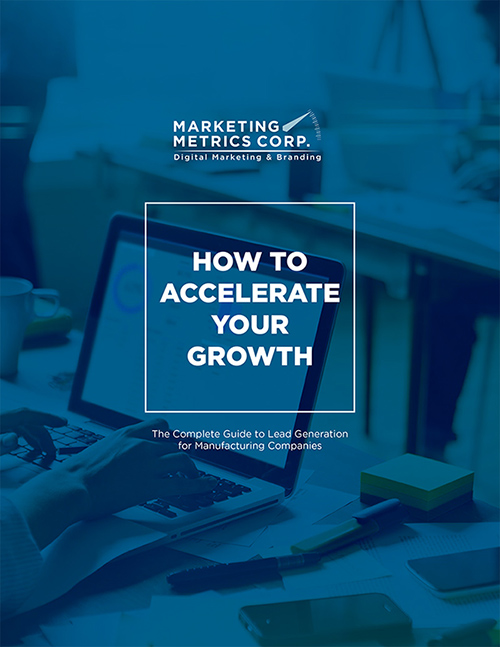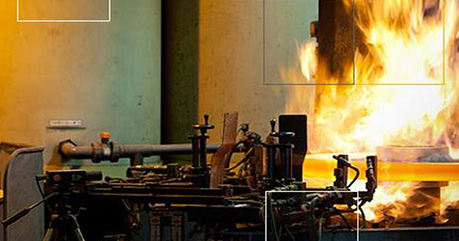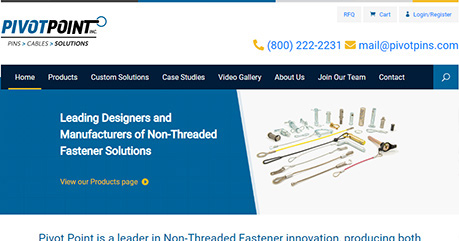Best Practices for An Industrial Website Design That Generates Leads
Businesses in every field need a website to help generate leads – industrial businesses included. Previously, the industrial sector had been less reliant on online marketing than most other business sectors, but that’s swiftly changing. In a global, borderless economy, it’s more important than ever to have a website that distinguishes you from your competition and helps capture the best leads to help you keep your manufacturing business growing.
Chances are, you have a website, but it probably hasn’t been updated in some time. In this guide, we’ll talk about current best practices for designing an industrial website as of 2019, and how to make it effective at generating leads.
The Best Practices for Lead-Focused Industrial Website Design
- Know Your Leads
Before you can optimize a website for lead generation, you need to know who your best leads will be.
The emphasis here should be on best leads. One of the hard-learned lessons of Internet marketing over the past decade is that it’s relatively easy to get a gigantic list of names and email addresses – but that’s not always a good thing. If you have a huge list full of poorly qualified leads who are unlikely to convert into customers, that will ultimately just end up wasting your sales team’s time. They’ll spend far too much time chasing leads who aren’t worth the effort and potentially even allow good leads to slip through the cracks.
So, your website will ultimately be about gathering leads, but it will be focused on gathering the best leads. This brings us to the central question: who are your best leads?
Look through your customer database. What you’re looking for are commonalities between your best customers, particularly from a long-term perspective. What industries are they in? Where are they located? What is their spending capacity? Who was the actual purchasing decision-maker, and what was their role in the company? What do you know about those decision-makers personally?
As much as possible, answer these questions based on hard historical data.
Once you have this information, you’ll want to create a buyer persona. Or possibly more than one if you’ve identified multiple distinct lead types. A buyer persona is a sort of character sheet, describing who an ideal lead for your company is. It covers their basic information but also attempts to dig into their psychology, such as pain points and life goals. The more detailed you can make it, the better.
Then, as you’re going ahead with your industrial website design, you can refer to this buyer persona to make sure you’re always targeting those optimal buyers with your marketing efforts.
- A Quick Overview Of SEO
Search Engine Optimization – SEO – is at the heart of all business to bsuiness website design. SEO is a series of principles for helping search engines (mostly Google) identify your site and place it high up on lists of relevant search results. This is of critical importance! Most people running online searches – upwards of 80-90% – will never click past the first page of results. If you aren’t on that first page, you’re basically invisible to them.
There are several facets of SEO, but the most important revolves around the use of keywords. Keywords are words or phrases that people are typing into Google which, ideally, should lead them to your site. All the content on your website should be written to utilize these keywords, to help point Google towards you.
Fortunately, Google offers a free keyword discovery tool, to help you get started. Look for keywords closely related to your site, as well as those of your competitors. Additionally, pay attention to questions being asked. Answering questions people ask of Google, which are relevant to your business, makes for extremely effective SEO.
There are several other aspects to SEO but we’ll touch on those as we discuss the actual industrial website design itself.
III. Key Principles for An Industrial Website Design
Once you have buyer personas in place and lists of the keywords and questions they’re likely to be putting into Google, the website design can begin in earnest.
As far as the visual design goes, that’s up to you. Your website needs to be reasonably attractive to visitors, but the actual aesthetics are less important than you might think. Usability and creating a strong user experience are still much more important, particularly in a pragmatic field like industrial work. Let form follow function.
However, you do want the visitor’s first impression to be good! A typical website visitor decides within ten seconds whether they want to continue looking at a page. So, do whatever it takes to hook their eyeballs in those first few moments, then get on with a more practical presentation.
Now, here are some more concrete things to consider with your industrial website design.
1 – Mobile-friendliness is a must.
You’ll want your website designer to utilize adaptive design in building your website. That means the website can automatically reshape itself to fit whatever device the visitor is using. It’s vital that the website be equally usable – and provide a comparable experience – whether the user is on a desktop machine or a mobile device.
This isn’t merely good design in terms of broad appeal. Google heavily pushes adaptive design and will give SEO bonuses to websites that render well on a wide variety of devices.
Plus, as a corollary to this: be thumb-friendly. Try to place interactive elements towards the center of your design because that’s where mobile users’ thumbs will be. Avoid sidebars – especially sidebars at the left – whenever possible.
2 – Minimize the number of onscreen options.
As a rule, people become uncomfortable when they have too many options without good ways of differentiating between them. This is sometimes called “choice paralysis,” and if you’ve ever spent more time staring at listings in Netflix than watching shows, you’ve experienced it.
Good industrial website design seeks to limit the number of onscreen options to around 6-9, at most. There may be specific exceptions to this – particularly if you have an online catalog – but the basic website design should be as streamlined as possible. You want to give your users enough choices to navigate effectively, without overwhelming them with too many choices.
However, this also creates a great opportunity for you to develop well-defined paths through your website. You don’t want people browsing around aimlessly if you can avoid it. You want to guide them towards becoming leads and customers. Restricting their navigation options can be a highly effective way to guide them down the proverbial garden path.
3 – Give plenty of opportunities for visitors to become leads
To become leads, visitors must reach out and contact you or else give you a way to contact them. This needs to be encouraged by putting calls-to-action (CTAs) in as many places as possible. Many websites, for example, have a space on one side which is continually asking them to sign up for a mailing list. Others make sure to put their own phone number front and center on every page.
Basically, a visitor should never be looking at a page that doesn’t give them at least one method of converting into a lead.
Also, landing pages are one of your best lead generation tools – and a prime focus of SEO. A landing page is a self-contained page on your website which contains a specific offer, usually for a piece of premium content, in exchange for contact information. The basic value proposition is: “You give us your email address and we’ll let you watch this highly informative video!”
These should use all the best tactics you’ve gleaned from studying your prime leads and utilize plenty of relevant keywords/questions to attract as many views as possible.
And speaking of creating content:
4 – Try to be at least as informative as you are “salesy.”
People expect an industrial website to be focused on selling a product or service, but don’t overdo it. Websites which are wholly self-focused will tend to turn off visitors, especially younger visitors such as millennials. You want to mix in plenty of content, which is genuinely informative, as you also push the virtues of your own products or services.
Again, this is where it helps to be informed about your buyers and their search habits. The better you know them, the easier it is to develop content that they’ll find compelling.
On the topic, also keep in mind that your content may be seen by many different individuals within a company. Be careful about using too much technical jargon. A visiting engineer might understand it – but what if their purchasing decision is being vetted by the buyer or CFO? Even as you target your best leads, keep in mind that you’ll likely have a wide audience.
- Moving Forward with Your Industrial Website Design
This should give you a good idea of what to focus on as you continue to develop your website. As one final tip: Don’t be afraid to experiment! Utilize A-B testing, just as you would with product R&D to identify the most effective designs, layouts, and content types to reach your audience.
If you need more assistance in creating a great industrial website, Marketing Metrics Corp. is always here for you. Our team collectively has decades of marketing and online design experience and we focus exclusively on the industrial sector. We can help you make your industrial website design clean and responsive, with a great user experience, while still generating the leads you need.
Please contact us directly for a full consultation on our services.









